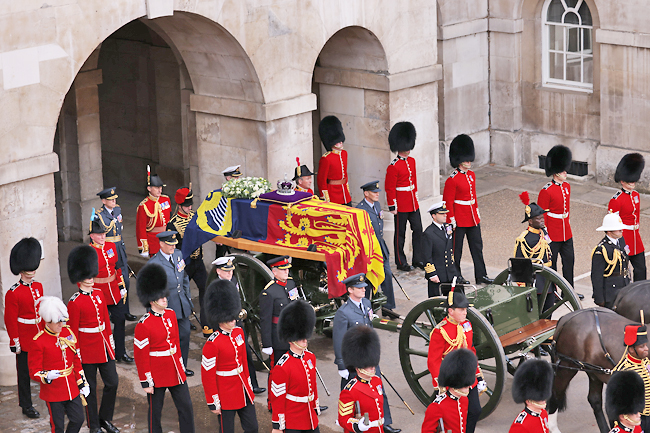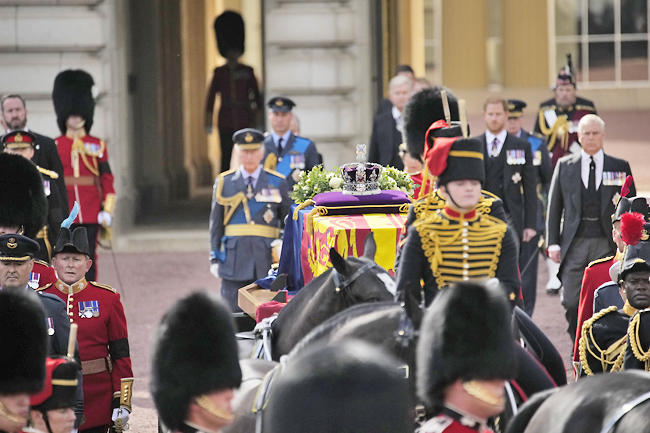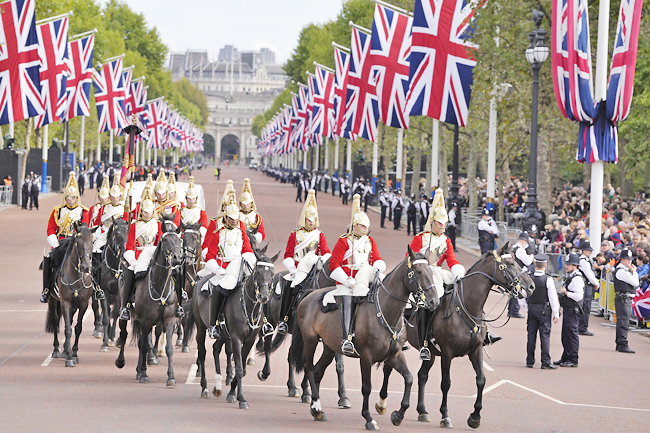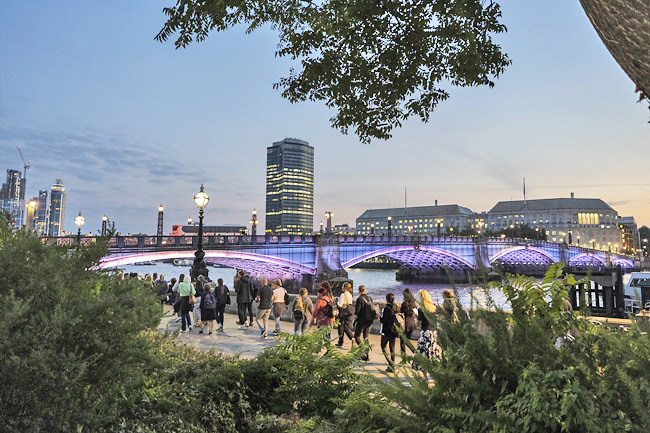LONDON (AP) – The coffin of Queen Elizabeth II left Buckingham Palace for the last time on Wednesday, borne on a horse-drawn carriage and saluted by cannons and the tolling of Big Ben, in a solemn procession through the flag-draped, crowd-lined streets of London to Westminster Hall. There, a steady stream of mourners paid their respects to Britain’s longest-reigning monarch.
As the cortege left the palace, her son, King Charles III, and his siblings and sons marched behind the coffin, which was topped by a wreath of white roses and her crown resting on a purple velvet pillow.
The military procession underscored Elizabeth’s seven decades as head of state as the national mourning process shifted to the grand boulevards and historic landmarks of the United Kingdom (UK) capital.
At 900-year-old Westminster Hall, where the queen will lie in state until her funeral Monday, crowds shuffled past her coffin well into the night. They moved silently down the steps of the hall under a great stained glass window, then past the coffin that was covered with the Royal Standard and had been placed on a raised platform known as a catafalque by eight pallbearers.
There were couples and parents with children, veterans with medals clinking on navy blue blazers, lawmakers and members of the House of Lords. Some wore black or suits and ties, others jeans and sneakers, and all had waited hours to stand in front of the coffin for a few moments
Many bowed or curtseyed and some were in tears.




Thousands who had waited for the procession for hours along The Mall outside the palace and other locations along the route held up phones and cameras, and some wiped away tears, as the casket rolled by. Applause broke out as it passed through Horse Guards Parade. Thousands more in nearby Hyde Park watched on large screens.
The coffin was topped with the Imperial State Crown – encrusted with almost 3,000 diamonds – and a bouquet of flowers and plants, including pine from the Balmoral Estate, where Elizabeth died on September 8 at the age of 96.
Two officers and 32 troops from the 1st Battalion Grenadier Guards in red uniforms and bearskin hats walked on either side of the gun carriage. The 38-minute procession ended at Westminster Hall, where Archbishop of Canterbury Justin Welby led a service attended by Charles and other royals.
After a short service, the captain of The Queen’s Company 1st Battalion Grenadier Guards, assisted by a senior sergeant, laid the royal standard of the regiment on the steps of the catafalque.
Four officers from the Household Cavalry – two from the Life Guards and two from the Blues Royals – began the vigil, taking their places at each corner and bowing their heads.
Thousands had queued up along the banks of the River Thames, waiting to enter the hall and pay their respects to the only monarch most Britons have ever known after her 70 years on the throne.
Esther Ravenor, a Kenyan who lives in the UK said she was humbled as she watched the procession.
“I love the queen, I love the royal family, and you know, I had to be here,” she said. “She is a true role model. She loved us all, all of us.
Especially someone like me, a migrant woman coming to the UK 30 years ago, I was allowed to be here and to be free and safe, so I really honour her. She was a big part of my life.”
Major General Christopher Ghika, of the Household division, who organised the ceremonial aspects of the queen’s funeral, said it was “our last opportunity to do our duty for the queen, and it’s our first opportunity to do it for the king, and that makes us all very proud.”
Troops involved in the procession had been preparing since the queen died. So had the horses of the King’s Troop Royal Horse Artillery.
Sergeant Tom Jenks said the horses were specially trained, including how to handle weeping mourners, as well as flowers and flags being tossed in front of the procession.
Heathrow Airport temporarily halted flights, saying it would “ensure silence over central London as the ceremonial procession moves from Buckingham Palace to Westminster Hall”.
United States (US) President Joe Biden spoke on Wednesday with Charles to offer his condolences, the White House said.
Biden recalled “the Queen’s kindness and hospitality” she hosted them and the first lady at Windsor Castle in June, the statement said.
“He also conveyed the great admiration of the American people for the Queen, whose dignity and constancy deepened the enduring friendship and special relationship between the United States and the United Kingdom.”
Crowds have lined the route of the queen’s coffin whenever it has been moved in its long journey from Scotland to London.
On Tuesday night, thousands braved a typical London drizzle as the hearse, with interior lights illuminating the casket, drove slowly from an air base to Buckingham Palace.
Earlier, in Edinburgh, about 33,000 people filed silently past her coffin in 24 hours at St Giles’ Cathedral.
The line of people snaking along the banks of the River Thames to enter Westminster Hall, the oldest building in Parliament, was nearly three miles long in the afternoon, according to a government tracker.
The hall is where Guy Fawkes and Charles I were tried, where kings and queens hosted magnificent medieval banquets, and where ceremonial addresses were presented to Queen Elizabeth II during her silver, golden and diamond jubilees.





